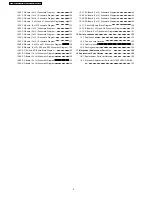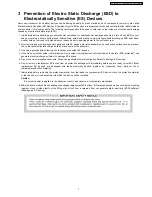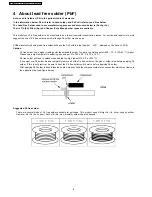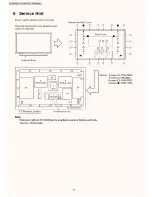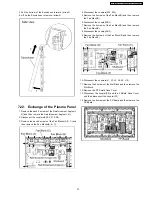
2.1.1. Leakage Current Cold Check
1. Unplug the AC cord and connect a jumper between the two
prongs on the plug.
2. Measure the resistance value, with an ohmmeter, between
the jumpered AC plug and each exposed metallic cabinet
part on the equipment such as screwheads, connectors,
control shafts, etc. When the exposed metallic part has a
return path to thechassis, the reading should be between
1M
Ω
and 5.2M
Ω
.
When the exposed metal does not have a return path to
the chassis, the reading must be
.
Figure 1
2.1.2. Leakage Current Hot Check (See
Figure 1.)
1. Plug the AC cord directly into the AC outlet. Do not use an
isolation transformer for this check.
2. Connect a 1.5k
Ω
, 10 watts resistor, in parallel with a 0.15µF
capacitors, between each exposed metallic part on the set
and a good earth ground such as a water pipe, as shown in
Figure 1.
3. Use an AC voltmeter, with 1000 ohms/volt or more
sensitivity, to measure the potential across the resistor.
4. Check each exposed metallic part, and measure the
voltage at each point.
5. Reverse the AC plug in the AC outlet and repeat each of the
above measurements.
6. The potential at any point should not exceed 0.75 volts
RMS. A leakage current tester (Simpson Model 229 or
equivalent) may be used to make the hot checks, leakage
current
must
not
exceed
1/2
milliamp.
In
case
a
measurement is outside of the limits specified, there is a
possibility of a shock hazard, and the equipment should be
repaired and rechecked before it is returned to the
customer.
2 Safety Precautions
2.1. General Guidelines
1. When servicing, observe the original lead dress. If a short circuit is found, replace all parts which have been overheated or
damaged by the short circuit.
2. After servicing, see to it that all the protective devices such as insulation barriers, insulation papers shields are properly
installed.
3. After servicing, make the following leakage current checks to prevent the customer from being exposed to shock hazards.
6
TH-65PHD7UY / TH-65PHD7EK / TH-65PHD7BK
Summary of Contents for TH65PHD7UY - 65" PLASMA
Page 5: ...1 Applicable signals 5 TH 65PHD7UY TH 65PHD7EK TH 65PHD7BK ...
Page 10: ......
Page 27: ...8 Location of Lead Wiring 27 TH 65PHD7UY TH 65PHD7EK TH 65PHD7BK ...
Page 28: ...28 TH 65PHD7UY TH 65PHD7EK TH 65PHD7BK ...
Page 36: ...36 TH 65PHD7UY TH 65PHD7EK TH 65PHD7BK ...
Page 37: ...37 TH 65PHD7UY TH 65PHD7EK TH 65PHD7BK ...
Page 38: ...11 2 HD 525i 525p 625i 625p panel white balance 38 TH 65PHD7UY TH 65PHD7EK TH 65PHD7BK ...
Page 39: ...39 TH 65PHD7UY TH 65PHD7EK TH 65PHD7BK ...
Page 41: ...12 2 No Power 1 No lit 41 TH 65PHD7UY TH 65PHD7EK TH 65PHD7BK ...
Page 43: ...13 Option Setting 13 1 How to access and setting 43 TH 65PHD7UY TH 65PHD7EK TH 65PHD7BK ...
Page 78: ...TH 65PHD7UY TH 65PHD7EK TH 65PHD7BK 78 ...
Page 152: ...TH 65PHD7UY TH 65PHD7EK TH 65PHD7BK 152 ...
Page 155: ...16 2 Fan and cover location 16 3 Cable relation 155 TH 65PHD7UY TH 65PHD7EK TH 65PHD7BK ...
Page 156: ...16 4 Packing summary 16 4 1 Assembling the paper box 156 TH 65PHD7UY TH 65PHD7EK TH 65PHD7BK ...
Page 157: ...16 4 2 Details of the paper box 157 TH 65PHD7UY TH 65PHD7EK TH 65PHD7BK ...
Page 158: ...16 4 3 Assembling the main packing 1 158 TH 65PHD7UY TH 65PHD7EK TH 65PHD7BK ...
Page 159: ...16 4 4 Assembling the main packing 2 159 TH 65PHD7UY TH 65PHD7EK TH 65PHD7BK ...




